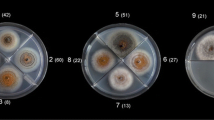Abstract
The Solanaceae and Rubiaceae families have close phylogenetic relationship, being members of the same Asterid clade of Eudicots. Species of the Solanaceae family are among the most important hosts for Ralstonia solanacearum (Rs), the causal agent of the bacterial wilt disease. In the present work, we investigated the potential host status of the genus Coffea to a diverse collection of Rs isolates. Pathogenicity tests were carried out under greenhouse conditions with nine Rs isolates from distinct geographic areas and host plants. Seedlings of three coffee (Coffea arabica) cultivars were inoculated via root dipping into a bacterial suspension. Plants of all cultivars were infected with three out of nine Rs isolates. Xylem vessels were colonized and plants developed typical wilt symptoms, although milder when compared with tomato seedlings used as controls. All isolates pathogenic to coffee were classified as phylotype I (previously race 1/biovar3). This finding, together with the remarkable pathogen plasticity, the reallocation of the coffee agricultural frontier to warm climate areas, and the current global warming trend are major driving forces of a stronger selection pressure towards Rs isolates pathogenic to coffee trees under natural conditions.

Similar content being viewed by others
References
Alfenas AC, Zauza EAV, Mafia RG, Assis TF (2009) Clonagem e doenças de eucalipto. 2ª Ed. Viçosa, MG, Brazil. Editora UFV
Álvarez B, Vasse J, Le-Courtois V, Trigalet-Démery D, López MM, Trigalet A (2008) Comparative behavior of Ralstonia solanacearum biovar 2 in diverse plant species. Phytopathology 98:59–68
Buddenhagen I, Sequeira L, Kelman A (1962) Designation of races of Pseudomonas solanacearum. Phytopathology 52:726
Elphinstone JG (2005) The current bacterial wilt situation: a global overview. In: Allen C, Prior P, Hayward AC (eds) Bacterial Wilt Disease and the Ralstonia solanacearum Species Complex. St. Paul, MN, USA. APS Press. pp. 9-28
Fegan M, Prior P (2005) How complex is the ‘Ralstonia solanacearum species complex’ ? In: Allen C, Prior P, Hayward AC (eds) Bacterial Wilt Disease and the Ralstonia solanacearum Species Complex. St. Paul, MN, USA. APS Press. pp 449-461
Genin S (2010) Molecular traits controlling host range and adaptation to plants in Ralstonia solanacearum. New Phytol 187:920–928
Ghini R, Hamada E (2008) Mudanças Climáticas. Brasília, DF, Brazil. Embrapa Informações Tecnológicas
Guyot R, Lefebvre-Pautigny F, Tranchant-Dubreuil C, Rigoreau M, Hamon P, Leroy T, Hamon S, Poncet V, Crouzillat D, de Kochko A (2012) Ancestral synteny shared between distantly related plant species from the asterid (Coffea canephora and Solanum sp.) and rosid (Vitis vinifera) clades. BMC Genomics 13:103
Hayward AC (1991) Biology and epidemiology of bacterial wilt caused by Pseudomonas solanacearum. Annu Rev Phytopathology 29:65–87
Hayward AC (1994) The hosts of Pseudomonas solanacearum. In: Hayward AC, Hartman GL (eds) Bacterial Wilt: The Disease and its Causative Agent, Pseudomonas solanacearum. Wallingford, UK. CAB International. pp 9–24
Kelman A (1954) The relationship of pathogenicity in Pseudomonas solanacearum to colony appearance on a tetrazolium medium. Phytopathology 44:693–695
Kelman A (1953) The bacterial wilt caused by Pseudomonas solanacearum. A literature review and bibliography. Raleigh, NC, USA. North Carolina Agricultural Experiment Station (Technical Bulletin no. 9).
La Porta N, Capretti P, Thomsen IM, Kasanen R, Hietala AM, Von Weissenberg K (2008) Forest pathogens with higher damage potential due to climate change in Europe. Can J Plant Pathol 30:177–195
Lebeau A, Daunay MC, Frary A, Palloix A, Wang JF, Dintinger F, Chiroleu F, Wicker E, Prior P (2011) Bacterial wilt resistance in tomato, pepper, and eggplant: genetic resources respond to diverse strains in the Ralstonia solanacearum species complex. Phytopathology 101:154–165
Lin C, Mueller LA, Mc Carthy J, Crouzillat D, Pétiard V, Tanksley SD (2005) Coffee and tomato share common gene repertoires as revealed by deep sequencing of seed and cherry transcripts. Theor Appl Genet 112:114–130
Malavolta VA Jr, Beriam LOS, Almeida IMG, Rodrigues Neto J, Robbs CF (2008) Bactérias fitopatogênicas assinaladas no Brasil: uma atualização. Summa Phytopathol 34:1–88
MAPA (2014) Information on coffee crops. Avaliable at: http://www.agricultura.gov.br/vegetal/culturas/cafe/saiba-mais. Acessed on July 2, 2014.
Nunes AML, Souza FF, Costa JNM, Santos JCF, Pequeno PL, Costa RSC, Veneziano W (2005) Cultivo do café Robusta em Rondônia. Sistemas de Produção 5. Porto Velho, RO, Brazil. Embrapa Rondônia
Poussier S, Pior P, Luisetti J, Hayward C, Fegan M (2000) Partial sequencing of the hrpB and endoglucanase genes confirms and expands the known diversity within the Ralstonia solanacearum species complex. Syst Appl Microbiol 23(4):479–486
Remenant B, Coupat-Goutaland B, Guidot A, Cellier G, Wicker E, Allen C, Fegan M, Pruvost O, Elbaz M, Calteau A, Salvignol G, Mornico D, Mangenot S, Barbe V, Médigue C, Prior P (2010) Genomes of three tomato pathogens within the Ralstonia solanacearum species complex reveals significant evolutionary divergence. BMC Genomics 11:379
Ricci MSF, Neves M (2006) Cultivo do Café Orgânico. Avaliable at: http://sistemasdeproducao.cnptia.embrapa.br/FontesHTML/Cafe/CafeOrganico_2ed/index.htm. Acessed on July 2, 2014.
Romo JP, Morales-Osorio JG, Yepes MS (2012) Identification of new hosts for Ralstonia solanacearum (Smith) race 2 from Colombia. Rev Prot Veg 27:151–161
Savary S, Nelson A, Sparks AH, Willocquet L, Duveiller E, Mahuku G, Forbes G, Garret KA, Hodson D, Padgham J, Pande S, Sharma M, Yuen J, Djurle A (2011) International agricultural research tackling the effects of global and climate changes on plant diseases in the developing world. Plant Dis 95:1204–1216
Author information
Authors and Affiliations
Corresponding author
Additional information
Section Editor: Andréa B. Moura
Rights and permissions
About this article
Cite this article
Lopes, C.A., Rossato, M. & Boiteux, L.S. The Host Status Of Coffee (Coffea arabica) To Ralstonia solanacearum Phylotype I Isolates. Trop. plant pathol. 40, 1–4 (2015). https://doi.org/10.1007/s40858-014-0001-9
Received:
Accepted:
Published:
Issue Date:
DOI: https://doi.org/10.1007/s40858-014-0001-9




